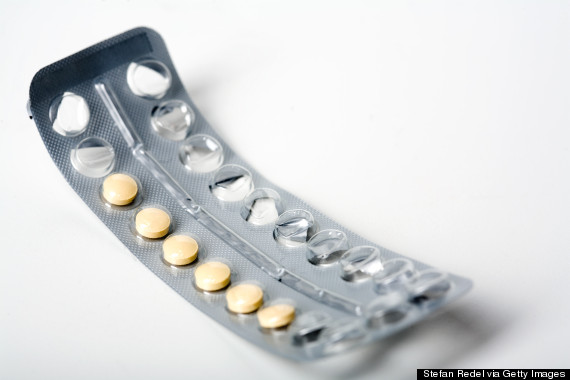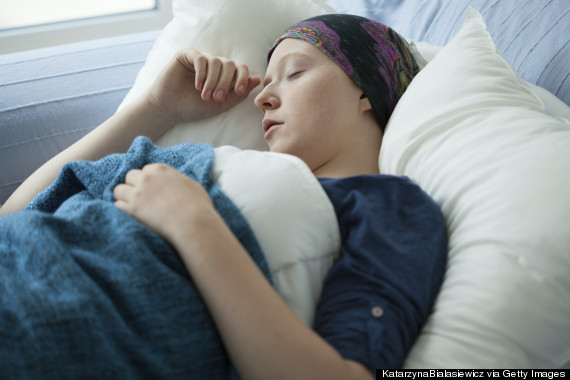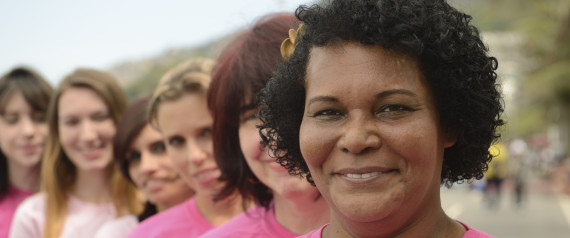The Most Important Breast Cancer Findings Of 2014
Posted: Updated:
It's estimated that 1 in 8 U.S. women will develop invasive breast cancer in their lifetimes, and about 40,000 American women are expected to die from the disease this year.
Learn more about the potentially life-saving research that has been published from research centers around the world.
The "Angelina Effect" Is Real


Actress and humanitarian Angelina Jolie made waves in May 2013 when she opted to have preventive double mastectomy after testing positive for the BRCA1 gene mutation, a mutation that greatly increases one’s chances of developing breast cancer in the future.
This year, a study published in the journal Breast Cancer Research reveals that Jolie’s announcement may be responsible for inspiring a wave of requests for genetic counseling and tests for breast cancer risk. In the U.K., referrals for genetic testing more than doubled after Jolie went public with her surgery, and they were mostly women who had a good reason to be concerned; many had a family history of breast cancer, just like Jolie. It was no one-time spike, either -- data from 12 different clinics and 9 genetic testing centers in the U.K. showed that a doubling of genetic test referrals for BRCA1 lasted from immediately after the announcement through October of that year.
A Simple Blood Test Could Soon Predict Breast Cancer Risk
Testing for the BRCA1 gene mutation isn’t the only way to test for elevated breast cancer risk. A simple blood test is currently being developed by researchers at University College London that will be able to predict a woman’s likelihood of developing the cancer by testing for a certain epigenetic signature -- the way certain genes express themselves, or the way genes are turned “on” or “off” -- that is present in women who had breast cancer but didn’t have the BRCA1 gene mutation.
Testing for the BRCA1 gene mutation isn’t the only way to test for elevated breast cancer risk. A simple blood test is currently being developed by researchers at University College London that will be able to predict a woman’s likelihood of developing the cancer by testing for a certain epigenetic signature -- the way certain genes express themselves, or the way genes are turned “on” or “off” -- that is present in women who had breast cancer but didn’t have the BRCA1 gene mutation.
"The data is encouraging since it shows the potential of a blood based epigenetic test to identify breast cancer risk in women without known predisposing genetic mutations,” said lead researcher Prof. Martin Widschwendter, Head of University College London's Department of Women's Cancer. The test was already being evaluated in human trials back when it was announced in June.
3-D Imaging May Be The Future Of Cancer Detection
A new kind of 3-D imaging technique called tomosynthesis could make the tumor search more accurate. A study published in JAMA found that in over 170,000 examinations that used both digital mammography and tomosynthesis, doctors were able to increase cancer detection rates while decreasing the amount of times they needed a patient to return because of an inconclusive reading (referred to in the study as “recall”).
A new kind of 3-D imaging technique called tomosynthesis could make the tumor search more accurate. A study published in JAMA found that in over 170,000 examinations that used both digital mammography and tomosynthesis, doctors were able to increase cancer detection rates while decreasing the amount of times they needed a patient to return because of an inconclusive reading (referred to in the study as “recall”).
Researchers found that using mammography and tomosynthesis together was better able to detect cancer than just mammography alone (the norm) at a rate of 5.4 per 1,000 vs. 4.2/1,000. The combined detection technique also detected invasive cancer at a rate of 4.1/1,000 vs. 2.9/1,000. As for recall, which wastes time and resources, mammography and tomosynthesis reduced the rates from 107/1,000 to 91/1,000.
Certain Birth Control Pills May Increase Risk


Women who had recently taken certain kinds of oral contraceptives -- specifically high-estrogen pills -- had a 50 percent higher risk of breast cancer than women who had never taken birth control pills or who stopped taking birth control pills. But the results should be interpreted with caution, said lead researcher Elisabeth F. Beaber, PhD, MPH of Fred Hutchinson Cancer Research Center in a press release about her study.
"Breast cancer is rare among young women and there are numerous established health benefits associated with oral contraceptive use that must be considered,” Beaber said. "In addition, prior studies suggest that the increased risk associated with recent oral contraceptive use declines after stopping oral contraceptives."
Instead of asking women to report how much birth control they had taken, which is the norm in these sorts of studies, Beaber culled information about pill brands, doses and length of time taken from pharmacies. She analyzed data from 1,102 women with breast cancer and compared them to 21,952 control women and found that pills with high estrogen increased breast cancer risk 2.7-fold, while pills with ethynodiol dictate increased risk 2.6-fold. Low-estrogen pills did not increase cancer risk. The study waspublished in the journal Cancer Research.
Common Fertility Drugs Do Not Increase Risk
Women who take the common infertility drug Clomid or gonadotropins (e.g. Pregnyl, Novarel, Profasi) needn’t worry that their quest for a baby opened them up to increased breast cancer risk. A study that followed women over 30 years finds that taking those drugs did not increase breast cancer risk, except for a very small amount of women who took Clomid for 12 or more cycles, who had more than 1.5 times the risk of contracting breast cancer as women who had never taken fertility drugs. Women who weren’t able to conceive after taking Clomid or gonadotropins had almost twice the risk of breast cancer as those who have never taken either medication, which suggests that the conditions that made them infertile could also have contributed to their eventual breast cancer diagnosis.
Women who take the common infertility drug Clomid or gonadotropins (e.g. Pregnyl, Novarel, Profasi) needn’t worry that their quest for a baby opened them up to increased breast cancer risk. A study that followed women over 30 years finds that taking those drugs did not increase breast cancer risk, except for a very small amount of women who took Clomid for 12 or more cycles, who had more than 1.5 times the risk of contracting breast cancer as women who had never taken fertility drugs. Women who weren’t able to conceive after taking Clomid or gonadotropins had almost twice the risk of breast cancer as those who have never taken either medication, which suggests that the conditions that made them infertile could also have contributed to their eventual breast cancer diagnosis.
Doctors today recommend taking only six cycles of Clomid at up to 100 mgs per dose before moving on to other fertility strategies. In the past, Brinton pointed out, doctors used to prescribe up to 250 mgs per dose, and for many years. The research analyzed data from more than 12,000 women being treated for infertility between 1965 and 1988. The study was published in the journal Cancer Epidemiology, Biomarkers & Prevention.
Diabetes May Increase The Size Of Breast Tumors
Adult onset diabetes could be making breast cancer tumors grow bigger, faster. A study presented at the European Breast Cancer Conference found that patients with Type 2 Diabetes were more likely to have advanced tumors when doctors first diagnose them with breast cancer.
Adult onset diabetes could be making breast cancer tumors grow bigger, faster. A study presented at the European Breast Cancer Conference found that patients with Type 2 Diabetes were more likely to have advanced tumors when doctors first diagnose them with breast cancer.
"We think that hyperinsulinemia -- where there are increased levels of insulin circulating in the blood -- may encourage the growth of tumour cells by providing them with large amounts of glucose, said lead researcher Dr. Caterina Fontanella, MD in a press release. "We therefore believe that strict control of blood sugar levels is essential to the successful treatment of breast cancer."
Skirt Size Is Linked To Breast Cancer Risk
It turns out that a growing “skirt size” makes women more likely to be diagnosed with post-menopausal breast cancer, according to a study published in the British Medical Journal.
It turns out that a growing “skirt size” makes women more likely to be diagnosed with post-menopausal breast cancer, according to a study published in the British Medical Journal.
Analyzing results from almost 93,000 women, researchers found that going up one skirt size every 10 years was linked to a 33 percent greater risk of breast cancer, while going up two skirt sizes in 10 years was linked to a 77 percent greater risk. Measuring “skirt size” isn’t really a proxy for weight gain; instead, think of it as a gendered way to describe waist circumference. Researchers already know that bigger the waist circumference is, the higher the risk for cancers like colon cancer and cancer of the uterus, as well as health risks like obesity, diabetes and cardiovascular disease.
The study doesn’t establish cause and effect, but researchers speculate that because abdominal fat is more “metabolically active” than fat in other parts of the body, it could be increasing estrogen levels, which can fuel the grown of breast cancer cells.
Good Quality Sleep Is Really Important For Recovery


Not only will being well-rested keep your immune system stronger, but it may predict a better recovery for breast cancer patients. Researchers at Stanford University found that “sleep efficiency,” or the ratio of actual sleep compared to total time spent in the bed, predicted survival time for patients with advanced breast cancer. Adjusting for factors like age and treatments for a pool of 97 women with advanced breast cancer, they found that efficient sleepers survived an average of 68.9 months, while inefficient sleepers survived an average of 33.2 months after studying them for six years.
"Good sleep seems to have a strongly protective effect, even with advanced breast cancer,” said researcher Oxana Palesh, PhD, assistant professor in the Department of Psychiatry and Behavioral Sciences at Stanford University in a press release.
Another sleep study demonstrated how melatonin, the hormone that makes you sleepy at night, is absolutely crucial to the success of tamoxifen, a widely used breast cancer drug. The only problem is that exposing yourself to light from your TV, mobile phone or computer at night shuts off that melatonin production, which in turn could weaken tamoxifen. To show this, researchers from Tulane University implanted rats with human breast cancer cells and then regulated their light to alternate between 12 hours of light and 12 hours of total darkness for several weeks. Then they repeated the light/dark cycles, but this time they shone a very dim light during the dark portion, which suppressed melatonin production. Tamoxifen was most effective in rats that had 12 hours of unadulterated darkness, or rats who received melatonin supplements.
"High melatonin levels at night put breast cancer cells to 'sleep' by turning off key growth mechanisms,” explained researcher David Blask of Tulane University in a press release. "These cells are vulnerable to tamoxifen. But when the lights are on and melatonin is suppressed, breast cancer cells 'wake up' and ignore tamoxifen.”
Vitamin D Levels Predict Breast Cancer Patient Survival
Patients with high levels of vitamin D were more than twice as likely to survive breast cancer than women with low levels of vitamin D, according to a study published in the journal Anticancer Research. Researchers from University of California, San Diego analyzed five past studies of breast cancer patients, which altogether had data from 4,443 people. Women who had a greater chance of surviving breast cancer had an average vitamin D level of 30 nanograms per milliliter, while the women who had less chance of surviving had an average of 17 nano grams per milliliter. Unfortunately, the average breast cancer patient in the U.S. has vitamin D levels that mostly resemble the latter, not the former.
Vitamin D Levels Predict Breast Cancer Patient Survival
Patients with high levels of vitamin D were more than twice as likely to survive breast cancer than women with low levels of vitamin D, according to a study published in the journal Anticancer Research. Researchers from University of California, San Diego analyzed five past studies of breast cancer patients, which altogether had data from 4,443 people. Women who had a greater chance of surviving breast cancer had an average vitamin D level of 30 nanograms per milliliter, while the women who had less chance of surviving had an average of 17 nano grams per milliliter. Unfortunately, the average breast cancer patient in the U.S. has vitamin D levels that mostly resemble the latter, not the former.
Because this was an observational study, the researchers recommended randomized clinical trials to confirm the causal relationship, but added that there’s no harm in adding vitamin D supplements to strengthen a breast cancer treatment regime now.
Breast Cancer Vaccines Could One Day Be A Reality
An experimental breast cancer vaccine called GP2 is showing a lot of promise in human trials and could one day be an important option to prevent recurrence in breast cancer survivors. Researchers divided 190 breast cancer survivors into two groups: a control which received only an immune stimulant and an experimental group which received the immune stimulant and the vaccine. The group which received the experimental vaccine had a 57 percent reduced breast cancer recurrence rate as compared to the control group.
An experimental breast cancer vaccine called GP2 is showing a lot of promise in human trials and could one day be an important option to prevent recurrence in breast cancer survivors. Researchers divided 190 breast cancer survivors into two groups: a control which received only an immune stimulant and an experimental group which received the immune stimulant and the vaccine. The group which received the experimental vaccine had a 57 percent reduced breast cancer recurrence rate as compared to the control group.
"The ultimate goal is to develop a preventative tool that will minimize the risk of recurrence in women who have already had breast cancer and for whom standard therapies have failed,” wrote principal investigator Elizabeth Mittendorf, M.D., Ph.D. of the University of Texas.
It’s Never Too Late To Make Lifestyle Changes
Two studies from Yale Cancer Center find that breast cancer survivors who start regularly exercising and eating healthier can decrease their risk for breast cancer recurrence and death, as well as improve overall quality of life.
Two studies from Yale Cancer Center find that breast cancer survivors who start regularly exercising and eating healthier can decrease their risk for breast cancer recurrence and death, as well as improve overall quality of life.
The first study divided obese or overweight female cancer survivors into two groups: those who got help and counseling about weight loss, and those who received simply a brochure. In addition to losing more weight, the women who got help with weight loss experienced a decrease in C-reactive protein, which is linked to a higher risk of breast cancer recurrence.
The second study divided breast cancer survivors into two groups: those who strength-trained twice a week and did 2.5 hours of aerobic activity per week, and those who did not exercise. After a year, the exercisers had also experienced a significant decrease in C-reactive protein compared to the control group -- as well a decrease in body weight and body fat.


No comments:
Post a Comment